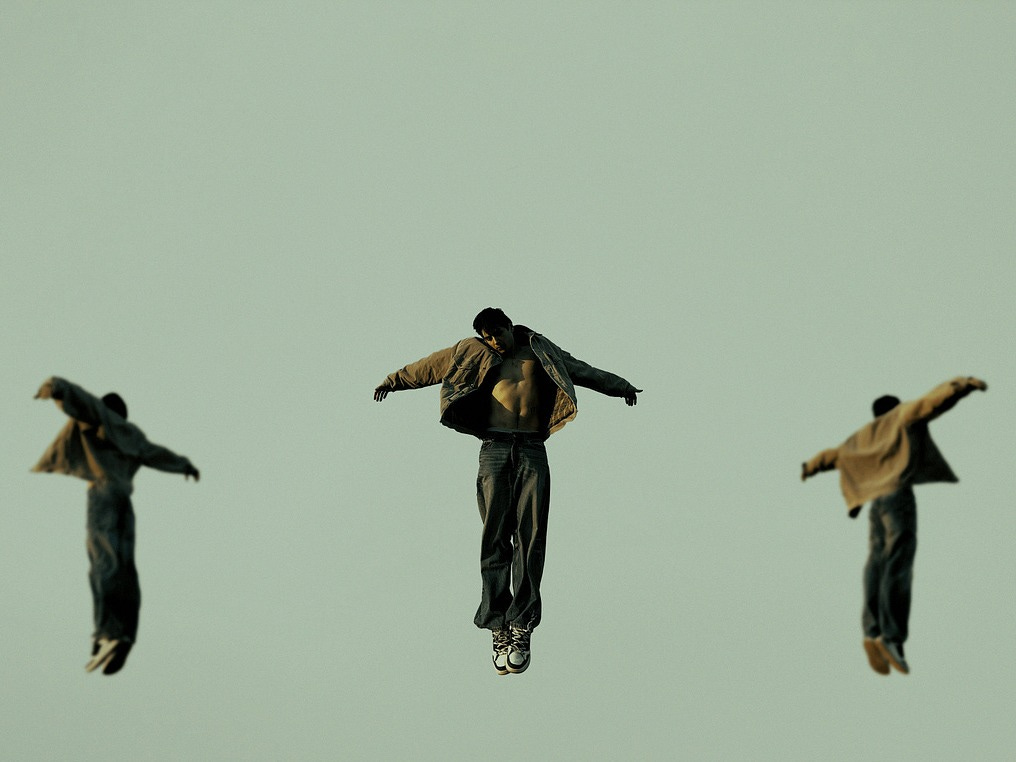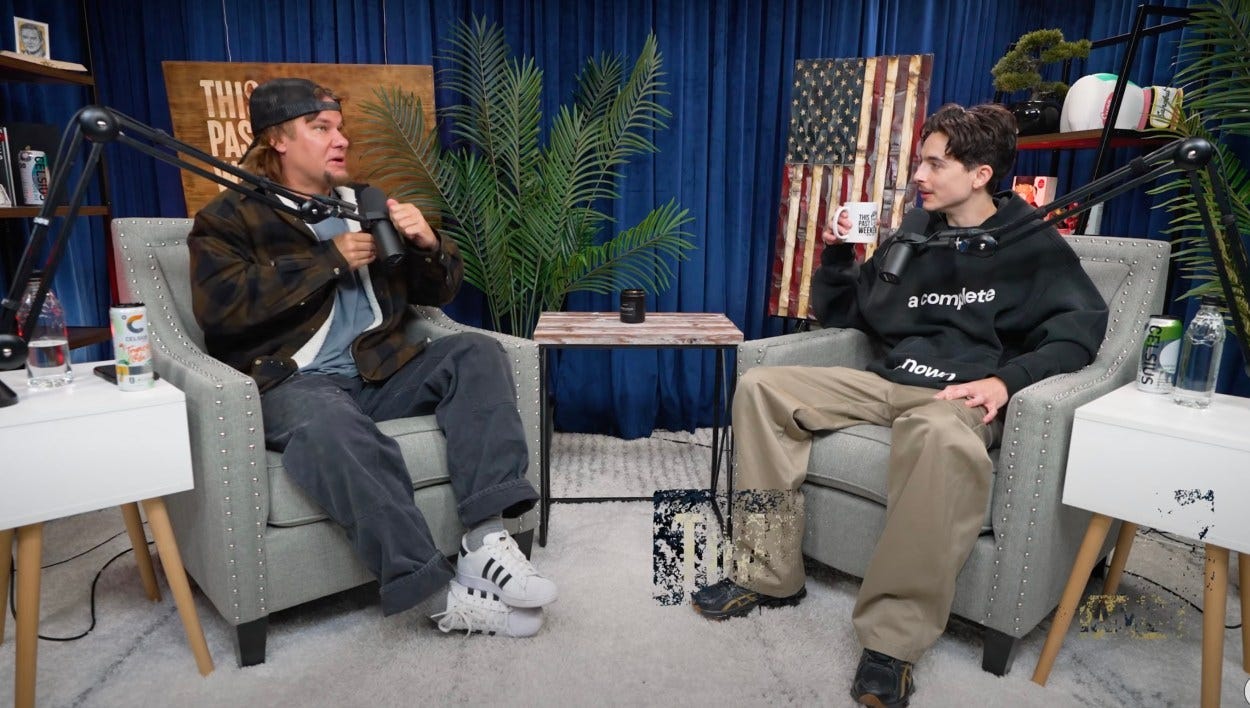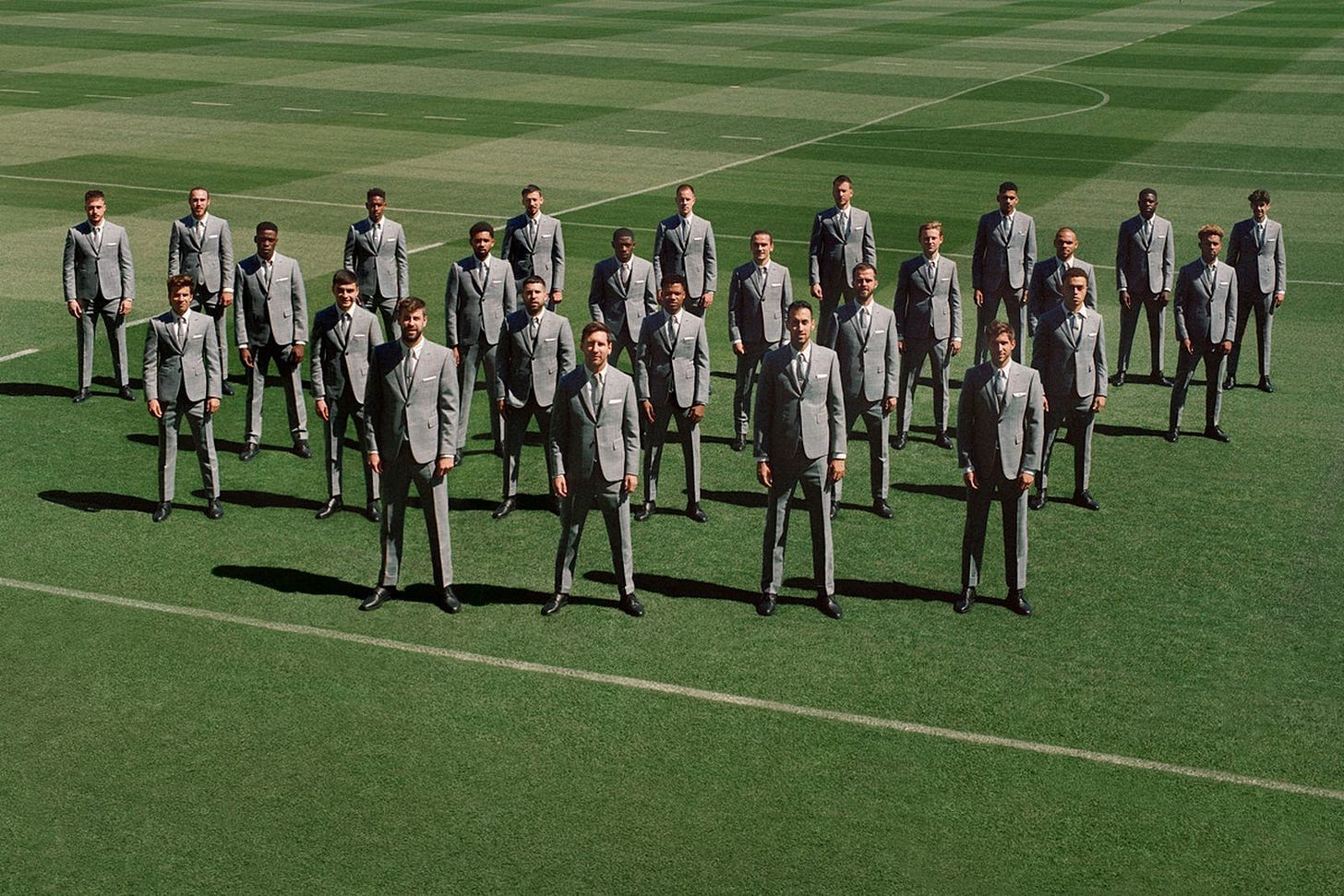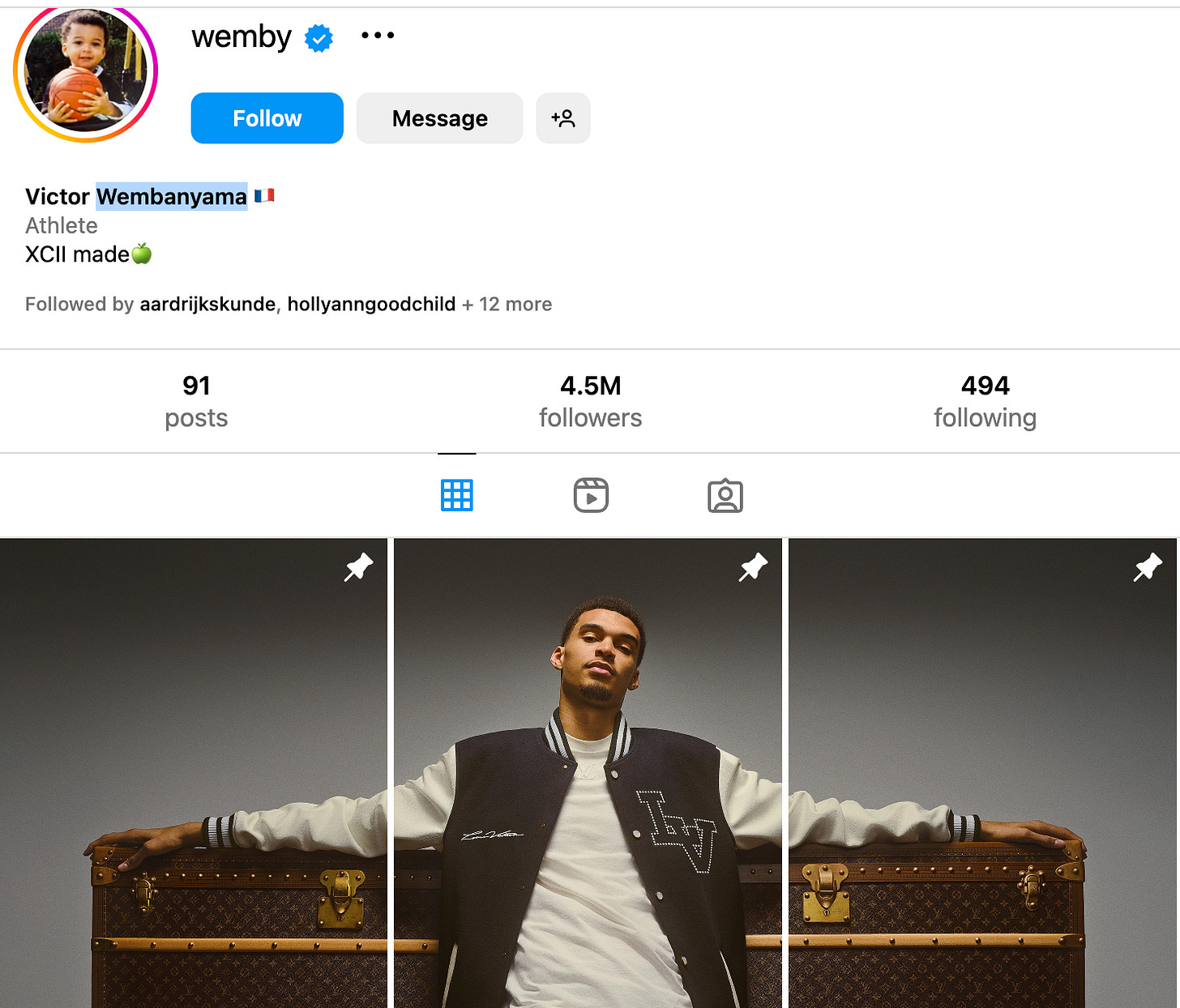Man-Made Culture
Men created a grassroots cultural movement with toxic edges. Now, brands must reach them through it.
For many businesses in the fashion and luxury industries, men are – at least economically – impossible to ignore. By way of illustration, in 2025 the revenue generated by the men's apparel market worldwide is forecast to reach $590.5 billion. Men, particularly young men, are a significant demographic for luxury: McKinsey data attests that, for four years now, over 60% of Millennials who occasionally treat themselves to luxury goods are male consumers.
The tech bro glow-up – fake tan for Mark Zuckerberg, Mounjaro for Elon Musk, Loro Piana for Sam Altman – is just one sign of changing symbols for men: looking good is now a marker of power and status.
As the meaning of what it is to be a man today continues to be scrutinised and our cultural perception of gender expands beyond the binary, businesses now face two polarised images of masculinity. At one pole, the gender-additive, are the men who seek to add non-traditional experiences and expressions to masculinity, championed by the likes of Paul Mescal, A$AP Rocky, Jacob Elordi, Tyler the Creator, and Timothée Chalamet. At the other, the gender-reductive, typified by the likes of podcast bros Joe Rogan and Theo Von, who espouse a fixed binary in both behaviour and identity markers like fashion.
Despite the media’s insistence on dramatising this polarisation between the trad-alpha and soy-bean beta, there is significant opportunity for the fashion and luxury industries to better engage the male-identifying customer.
As Chris Black, co-host of the How Long Gone podcast, tells Matter: “The biggest shift [in men’s culture] is that it’s cool to be into clothes as a man… Guys want to buy them, just to buy them and to be a part of something. It used to be, not even weird, it just wasn’t popular culture.” The challenge is now not stimulating interest and engagement, but rather navigating the at-times toxic channels and forums popular with men.
Given the reach, scale, and relevance of some manosphere creators to men, it’s important not to dismiss all of these creators as a reactionary niche. Engagement is not alignment. In what Matter is calling the clip-ification of media, the minutes-long sections of hour-long video podcasts which are posted on TikTok and Instagram are drawing users to tailored, bitesized content taken out of larger context. As The Verge reports, the relationship between on-app engagement and actual listening is weak, at best. Audiences are engaging only in the parts they agree with.
Certainly the toxic manosphere is one manifestation of this movement – but, despite media attention, it is not the only space in which young men are converging. Its methods of dissemination, however, are a bellwether for men’s digital behaviour, which is significantly different from their female counterparts.
The key takeaway for brands is that none of this is occurring in a vacuum. Men’s role in culture has had such little innovation in the last few decades that men have sought to find their own spaces, identities, and figureheads. Now, their lived experience is dictating their digital behaviour.
Lone Wolves Are Actually Lonely Wolves
Men are experiencing an acute loneliness crisis: just 27% of men say they have at least six close friends, and 15% report having no friends at all, according to the American Survey Centre. As a result, digital connection is a priority for young men, compared to women, and represents a significant share of the pie in their cultural diet.
Almost twice as many men versus women (41% vs 22%) say they spend more time in online communities rather than scrolling on social media, shares The Verge. Impact 360 Institute found that 54% of Gen Z men say they prefer their online connections over people in real life. They also prefer people to scrolling. A study by the Dutch national statistics bureau found that 78% of men want deeper human interaction than what they experience today, and that 84% of men are looking for more in the future compared to 73% of women.
No wonder that the bro-y, locker room vibes and the bluffing big brother energy of (literally) 5 foot 3 Joe Rogan and 45 year-old mullet-sporter Theo Von appeal. Indeed, bro-casting now leads the podcast charts. The top podcast in the U.S. is The Joe Rogan Experience, the fourth is This Past Weekend With Theo Von. Men make up 57% of monthly podcast listeners in the U.S., according to Statista. However, the reason behind their success does not align with the machismo they espouse. As it turns out, all those lone wolves are actually lonely wolves – who don’t see themselves reflected in mainstream media.
“If young men aren’t getting the representation they seek from Hollywood, they’re just going to go to YouTube,” reports the National Research Group in their study of young men’s cultural heroes. 54.3% of YouTube's user base is male. The NRG reports that the YouTuber MrBeast is the top real-world role model for Gen Alpha – he has more subscribers than any other YouTube channel (402 million) and he is also the third most-followed creator on TikTok.
Gaming and streaming are also a significant arena for the male culturesphere. 63% of livestream gaming website Twitch’s 240 million monthly users are men. 37% of men are introduced to new music via gaming. And 56% of boys compared to 35% of girls report making online friends through gaming.
If loneliness is driving how men spend their time online, the cultural causes shaping the rhetoric of the manosphere are more predictable.
It’s An Economic and Social Freefall, Bro!
As John Burn-Murdoch and Juliet Riddell of the Financial Times pointed out in their recent talk for SXSW London, “As men lose relative privilege, equality feels like oppression to some — fuelling resentment.”
Today, most men are experiencing a cultural and economic drift which leaves them vulnerable to alt-right voices. Sociologists widely agree that men are in a downward spiral: an identity crisis spurred by what researcher Richard Reeves calls “a sense of passivity”. Men still earn more on average than women, an estimate of 20% more globally, and 90% of FTSE 100 CEOs are men, according to Fortune. But, younger men — who represent the majority of digital male communities — are experiencing a social freefall.
Only 39% of American young men are enrolled in college, and enrollment for men in South Korea, China, and Taiwan has also fallen. In several European countries, the gender gap has actually now reversed and women under 25 now earn more than young men.
Indeed, compared to the homogeneity of the ‘90s and the ‘00s, over the past decade in the Western world, the zeitgeist and wider society have sought to support greater equality, creating space for traditionally underrepresented groups. In some cultural vectors, this has come at the cost of male dominance in communication channels—but has in no way reached a point where men are disproportionately excluded. However, male identity is at a point of flux.
Matter Intelligence interviewed a 37-year-old father of one in a long term relationship, who earns between £120-150k, works as a director at a hospital and has a degree but no post-graduate qualifications. They described it as this:
“I think it is clear that there is a large proportion of men with low self value and a narrative that has been pushed forward in the media because there were disparities that needed to be improved. That narrative, which isn't pushing the virtues of men, created a perfect storm of pushing men to the side.”
Mulling the Manosphere
Now, boys being boys has become toxic. The reaction to that “perfect storm,” is a shift in tone. An increasingly global phenomenon, the issue at hand, culturally as well as politically, is the failure to “articulate a progressive masculinity that is more appealing than traditional masculinity”, as per the European Commission’s report on the subject.
Gender’s ideology is in fact diverging, with young women becoming more liberal and young men more conservative and increasingly sexist. Young men (under 25) are now typically more sexist than older men (55+). In the U.S. women are now on average of 30% more liberal than men.
The chasm in voting behaviour between young men and women attests how deep this really runs. In the 2024 American election, 57% of men under 30 voted for Trump, while 59% of women under 30 voted for Harris, as per the Navigator Research Exit Poll 2024.
The necessary and very positive ceding of cultural space to DEI, female and queer narratives, and the perceived weakening of the patriarchy has pushed the evolution of masculine identity into niche spaces. Indeed, the appeal of male-only culture is often that it is unsanitised by a cultural evolution most relevant to people in major cities and liberal industries; lifestyles that involve diversity.
Frank and unapologetic, this space is expressly and explicitly masculine and specific in interest, but not necessarily toxic. For example, highly influential podcasters Throwing Fits use the tagline “Two grown dirtbags……just tryna navigate the male zeitgeist.” This new expression of masculinity shows up in inside jokes, owned language and niche cultural interests. The new “shock jocks” are here — and they’re wearing Our Legacy Camion boots.
As Lawrence Schlossman recently told The New Garde with Alyssa Vingan: "You're part of the manosphere whether you like it or not [as a male podcaster]".
This is now a relatively uncontroversial media space. Case in point: Timothée Chalamet, a key face in gender-confident fashion and additive, expressive, fashion-literate masculinity, was interviewed on This Past Weekend With Theo Von. In the media and social media discourse around Timothée’s appearance on the show, very little was made of any possible dissonance between an actor minted in culture as a gay teenager in Call Me By Your Name versus his appearance on a podcast which had only weeks before batted for Trump, an antagonist to LGBTQIA rights.
Creating Space For the Consumers With the Most Space
“Men are lacking a sense of a secure place in the world. Masculinity doesn’t invent itself, and men are still too stuck on their source of meaning being from their occupation,” Richard V. Reeves told the New York Times. Brands can help and benefit by funding spaces that alleviate loneliness without undoing years of progress.
The first thing most brands should seek to do is ignore the boys’ noise. The worst of the manosphere is a toxic space populated with dangerous rhetoric. However, the contemporary shape of male online culture is a reality. It is naive to dismiss this significant cultural shift that reflects the experience — or the perceived experience — of men today, due to extremists at the edge.
The success of the manosphere speaks to a tide-change in media consumption and media culture, one which transcends political lines. Lauren Jarvis, a former Spotify executive, told the Financial Times: “People are tired of headlines, soundbites, and overly produced, pre-packaged shows. [These creators] are having a conversation... They express a little bit of their own opinions as well. That becomes very relatable and very intimate.”
These are important channels best navigated by aligning with the broader shift from influence to expertise and the innate interest in detail, lore and design in men’s fashion audiences.
Felicity Kay, stylist to Paul Mescal and numerous notable others told Matter:“So many of the boys I work with are like on Reddit threads about fashion and are in the weeds trying to find the next thing that people are after. It is that insider club feeling.”
By avoiding the firebrands of the men’s-movement but acknowledging male consumers’ authentic cultural expression, and their desire to enter communal spaces attuned to their experience, brands will gain dividends in consumer sentiment.
Sprezza, Fashion Roadman, Throwing Fits, How Long Gone – there is a vibrant ecosystem of fashion and style focused podcast that represent germane opportunities to create online communities for men to congregate and drive brand awareness.
Alternatively, entrepreneurial themes continue to connect to men, especially young men who have grown up in an age of entrepreneur-adulation. The top 10 most popular businesses focused podcasts (in fact, the top 13) are hosted by men. Many brands have an authentic connection to business and entrepreneurial themes due to their own commercial journeys. It is a synchronicity that should be further explored through sponsorship.
Men are also attuned to more populous online spaces than their female counterparts. They favour groups with more than 50 members, a fact that should be incorporated into storytelling devices and engagement strategies.
Performance Awareness
However, it is important to not miss the wood for the trees. Sports has always been seen as providing a unifying male space in culture, and men’s growing interest in wellness is only accelerating its importance.
Though sports and fashion have always had a symbiotic relationship, we’re now witnessing a new era of sport, celebrity, and fashion cross-pollination. It is now less concerned with sports products and more focused on the brand opportunities in athlete and fan-culture. Enter Kylian Mbappé at Dior.
Indeed, you can see the dramatic shift away from sports stars selling sport related products to sports stars just being the new stars. Louis Vuitton continues to spend like Croesus: they just announced sponsorship of Real Madrid, following midfielder Jude Bellingham being named as a "Friend of the House" last year. Victor Wembanyama, the NBA's top draft pick was also announced. He now has three connected posts pinned to the top of his Instagram account showing his armspan stretched across a trunk. He joins Antoine Dupont, a French rugby player, and tennis player Carlos Alcaraz.
As Chris Black says, “That's just where we're at.” Sport is no longer seen as hyper-masculine or super-obsessive — instead being embraced by casual fans. Its connection to fashion is only going to get stronger.
Matter unpacks this further here:
Brands would be well served to recognise the potential in partnering with young athletes that have a natural rapport with communities they have built from the earliest stages of their career. Athletes are also blessed with inbuilt relevance cycles: you don’t need to wait for the next entertainment vehicle to launch, just the next match in the season.
What Matters
Beyond the Toxic Manosphere: Men’s lived experience of loneliness and social freefall has prompted a significant change in their digital behaviour. No longer seeing themselves represented in mainstream media, they are creating their own culturesphere online.
Create Space: Men want to come together online and offline in forums which they perceive as favourable to them and understanding of their needs. Brands can create or support these spaces without engaging with toxicity.
Boys Just Wanna Buy Clothes: The male consumer is a significant and under-valued opportunity for the fashion and luxury industry. The challenge is not stimulating engagement and interest, but reaching men in the right spaces.
Straight Men Still Like Sports: They also interestingly enough represent the largest proportion of female-played sport fandom. Better utilising off-season and entering into partnerships with early-stage athletes aligns with the social zeitgeist.











